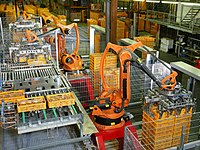
Photo from wikipedia
Rapid and precise analytical tools are essential for monitoring food safety and screening of any undesirable contaminants, allergens, or pathogens, which may cause significant health risks upon consumption. Substantial developments… Click to show full abstract
Rapid and precise analytical tools are essential for monitoring food safety and screening of any undesirable contaminants, allergens, or pathogens, which may cause significant health risks upon consumption. Substantial developments in analytical techniques have empowered the analyses and quantitation of these contaminants. However, conventional techniques are limited by delayed analysis times, expensive and laborious sample preparation, and the necessity for highly-trained workers. Therefore, prompt advances in electrochemical biosensors have supported significant gains in quantitative detection and screening of food contaminants and showed incredible potential as a means of defying such limitations. Apart from indicating high specificity towards the target analytes, these biosensors have also addressed the challenge of food industry by providing high analytical accuracy within complex food matrices. Here, we discuss some of the recent advances in this area and analyze the role and contributions made by electrochemical biosensors in the food industry. This article also reviews the key challenges we believe biosensors need to overcome to become the industry standard.
Journal Title: Foods
Year Published: 2018
Link to full text (if available)
Share on Social Media: Sign Up to like & get
recommendations!